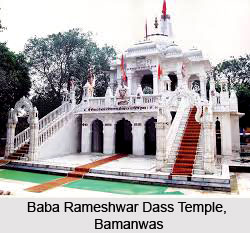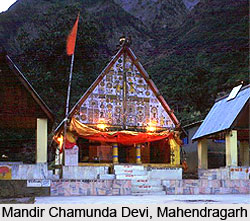 Religious Places in Mahendragarh in the northern Indian state of Haryana are numerous and due to the abundance of temples in this part of the country, this place is also referred to as `the town of temples`, like Pushkar. Some of these several temples are historic ally significant and comprise Mandir Chamunda Devi, Modawala Temple, Mandola and others.
Religious Places in Mahendragarh in the northern Indian state of Haryana are numerous and due to the abundance of temples in this part of the country, this place is also referred to as `the town of temples`, like Pushkar. Some of these several temples are historic ally significant and comprise Mandir Chamunda Devi, Modawala Temple, Mandola and others.
Mandir Chamunda Devi
Raja Naun Karan, a ruler of this area was considered to be a devotee of Chamunda Devi. At the foothills of a hill, he built a temple dedicated to Goddess Chamunda. Following the downfall of the dynasty of Raja Naun Karan, this region was conquered by the Mughals, who created a mosque on the temple of Chamunda Devi. It was called Jama Masjid. After Indian independence from the British Raj, the temple was discovered by the regional inhabitants of this town, thanks to their excavations. The temple was found to be damaged in certain portions. Today it is visited by many pilgrims and a great fair is conducted during Ram Navami.
Modawala Temple
This temple is dedicated to Lord Shiva and is located at Narnaul - Rewari Road near New Bus Stand. Modawala Mandir is the only local temple which is thronged by all Hindu families for the worship of Hindu deities and also Lord Shiva. During `Raksha Bandhan`, a grand fair is held near this temple. As per a legend, there was a `khet` or agricultural land at the site of the temple, where a farmer ploughing the field suddenly came across a Shiva linga while he was at his task. While the man was asleep, he heard a voice which told him that He was Lord Shiva and ordered him to construct a temple at the town so that the local people would be able to worship Lord Shiva. Thereafter, this temple was built. The regional residents of Mahendragarh believe that if someone worships Lord Shiva earnestly, he would definitely receive the divine blessings of this deity and all his desires would be fulfilled by Lord Shiva.
Dhosi Hill
Dhosi Hill is based at a distance of about 8 km away from the western part of Narnaul, near Kultajpur and Thana villages. This area is quite reputed since it is said that it is the very place where Chavan Rishi had performed penance for several years. The summit of Dhosi Hills contains a temple dedicated to Chavan Rishi. On `Somavati Amavasya`, a fair is arranged here. Chavan Rishi is believed to have founded the Bhargava community and he was belonged to `Bbirgu` dynasty. Haryana`s Bhargava communities are referred to as `Dhosar`. This place is considered quite holy and respected as a `Tirtha`. A well, tank and a Shiva temple are also existent on Dhosi Hill and the waters of the tank is said to be as sacred as that of Yamuna River and Ganga River.

Devotees from many parts of India visit the temple here to pray before the image of Chavan Rishi. They take a bath in the water tank, as it is believed that doing so a person would be cleansed from his past sins. There are separate bathing ghats for women and men. Pilgrims must climb 457 stairs of Dhosi Hill, which winds via Thana village. However, one might also approach Dhosi Hill through Kultajpur village and bathe in the Shiva Kund. A wall measuring about 5 to 6 feet in length is present near the stairway and pilgrims can proceed up the hill with the aide of this wall. Suraj Kund and Panch Tirathi are the two other important religious spots situated on this hill. On the top of Dhosi Hills, there exist two temples, one of which is aged about 100 years and the other about 250 years. Idols of Lord Krishna, Radha, Sukanya and Chavan Rishi are present in the premises of the main temple. One would also notice an `Ashta-dhatu` idol of Lord Vishnu, in the posture of `Shesh Shayya` here. There is a cave or `ghufa` near the temple where Chavan Rishi is said to have practiced `tapasya`. Legends state that the Rishi used to consume a herb known `Chavan Prash` which help him stay in good health.
Bagot
Situated at a distance of nearly 25 km from Mahendragarh, Bagot consists of a Shiva temple, near which a big fair is conducted annually on the eve of Shiva Ratri in `Shawan` month. Thousands of devotees visit Bagot to pray to Lord Shiva. It is believed that if pilgrims visit to Haridwar a week prior to their journey to Bagot and bring two pitchers filled with the water of Ganga River to this place on foot, it would bestow good luck upon them. The pitchers known as `kawars` must be not be placed on the earth as it would render them impure and must be sprinkled over the stone idol of Lord Shiva. `Bhajans` are sung in the praise of Lord Shiva throughout the day of this ritual.
Bamanwas
Bamanwas village is located about 25 km from Narnaul on the Haryana-Rajasthan border and is very popular for the presence of a temple of Baba Rameshwar Dass. The temple was created in 1963 by Rameshwar Dass. There are marble floors and beautifully adorned walls inside the temple premises, while one would notice marvellous idols of Gods and Goddesses in various rooms of the temple. There exists a temple of Lord Shiva on the right side of the temple, which houses an image of Nandi which measures about 25 feet. A special Shiva Linga which is 10 feet in height has been established near the images of Lord Shiva. The principles mentioned in Bhagavat Gita and Ramayana are written on the walls of this temple. There is a large idol of Lord Hanuman near the main entrance of the temple. It measures about 40 feet in height and is one of the tallest idols of Hanuman in northern India. A vast number of devotees from regions like Kolkata, Delhi, Mumbai, Hyderabad, Ahmedabad and others throng this temple and the temple is maintained by donations from the inhabitants of all these cities. The Governments of Rajasthan and Haryana have ensured that devotees can travel safely to the temple by constructing metalled roads which lead to the temple. Every year, a giant fair is held during `Ram Navami`, wherein numerable people participate.
Kamania
The village of Kamania is located about 10 km away from Narnaul and it is famous for its Ram Mandir. The annual Shiva Ratri fair conducted here draws a large number of devotees from various portions of India.
Kanti
Baba Ganesh Dass and Baba Narsingh Dass were the two Indian saints who were born in Kanti village. As per a popular legend, Raja Hari Singh of Nabha was childless, but he was soon blessed in the form of a daughter as well as a son, thanks to the blessings of Baba Narsingh Dass. The saint named the son Tikla, who later became the next king of Nabha and was referred to as Tikla Singh. Raja Hari Singh then erected a temple for Baba Narsingh Dass which contained a `samadh` of marble and a tank. A small rest house is also present in this temple. During `Basant Panchami`, a fair is observed at the samadh of the Baba. Baba Ganesh Dass was also revered by the regional residents of Kanti and a grand fair is held on `Sankranti` near his `samadh`.
Mahasar
In Mahasar, Goddess Jwala is worshipped, particularly during the months of March till April, when the Jwala Devi Fair is held. Devotees offer wine before the image of Goddess Jwala and the temple dedicated to this Goddess is also visited by people for performing the `mundan` ritual for their babies. Newly married couples visit the temple and offer their prayers to Goddess Jwala for a happy married life.
Mandola
Mandola is quite significant, due to the saint named Baba Kesria who is deeply respected by the local inhabitants of Mandola. Every September a fair is held to commemorate this saint and it is widely believed that if a person visits this place he would be immediately cured of snake-bite.
Seylong
Seylong is yet another important religious place where a fair is celebrated in the memory of `Khimag Devta`, during January till February. It is said that a victim of leprosy attains relief if he lights a jot inside this shrine.



















